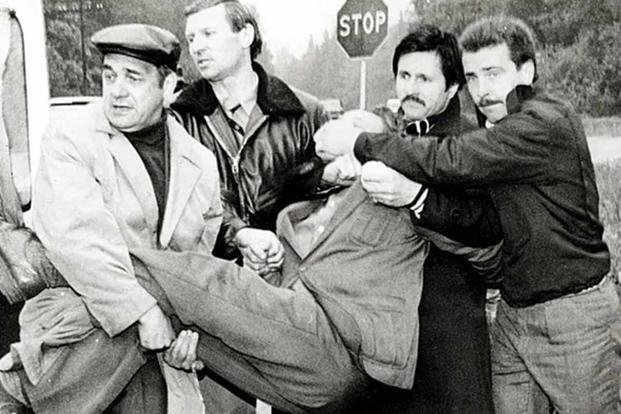Between 1978 and 1985, Russian radar expert Adolf Tolkachev passed Soviet military secrets to his CIA handlers that saved the United States an estimated $2 billion in defense research developments. It was an intelligence coup that earned him the nickname “the Billion Dollar Spy.” Despite the care he took to maintain his position inside the Soviet Union’s military apparatus and to protect himself and his family from the Soviet internal security service, he was discovered and executed.
A painting of Tolkachev by Kathy Krantz Fieramosca hangs in the CIA’s headquarters building in Langley, Virginia, and his story was recounted in author David E. Hoffman’s 2015 book, “The Billion Dollar Spy.” Now that book is being turned into a major Hollywood feature film starring Russell Crowe.
Tolkachev was an engineer, working on the Soviet Union’s anti-aircraft weapons and radar systems, but was not a loyal Soviet worker. According to Hoffman’s book, the Kazakh-born Tolkachev had become disillusioned with communism and felt a desire to exact vengeance for the death of his mother-in-law and the imprisonment of her husband. He approached a CIA officer in his car at a Moscow gas station in 1978, hoping to get his attention. The man in the car just happened to be Moscow Station Chief Gardner Hathaway.
Read Next: James Cameron’s First Non-‘Avatar’ Film Since ‘Titanic’ Is About the Man Who Survived Both Atomic Bombs
Hathaway recruited Tolkachev despite his doubts about the scientist’s motives, loyalty and trustworthiness. Tolkachev eschewed many of the usual demands from Soviet agents. He didn’t ask for a lot of money, initially refusing any sort of monetary payment. What he really wanted was Western music and art supplies for his son, Oleg. The rubles he did ask for were to be used in case he had to bribe co-workers to keep them silent. He also requested a cyanide pill he could use in case he was discovered. The CIA agreed and got way more than it ever thought possible.
Over the course of more than 20 meetings, in which the engineer refused to follow CIA protocol for fear it would lead to his discovery, Tolkachev gave the Americans detailed information about Soviet weapons, aircraft and radar systems. These include the Vympel R-23, R-27, R-33 and R-60 air-to-air missiles and the S-300 long-range, surface-to-air missile defense system. He also provided information about fighter aircraft, including the MiG-29 Fulcrum, the MiG-33 Foxhound and Su-27 Flanker. He even provided information about a new Russian air defense radar a full decade before it was put in place. Tolkachev’s turn was an intelligence coup that saved the United States billions in research and development.
But nothing lasts forever. Eventually, the KGB discovered Tolkachev’s work for the CIA.

On June 13, 1985, one of Tolkachev’s CIA handlers was surprised and arrested by more than a dozen KGB officers at the same time the two were supposed to meet. He was taken to the notorious KGB headquarters (and prison) Lubyanka and interrogated. The CIA officer happened to be carrying a package for his agent, a box filled with miniature cameras, rubles and Western art supplies. The case officer gave the Soviets nothing and was sent packing back to the United States.
As for the spy, the Soviet state news agency TASS announced Tolkachev was arrested for trying to pass secret materials to the USA. He was allegedly found with two million rubles at the time of his arrest. He was tried for his crimes in 1985 and executed in 1986, according to a Soviet Politboro transcript. All that was left for the CIA was to figure out exactly how the Soviets discovered Tolkachev’s work.
According to information provided by Soviet defector Vitaly Yurchenko, it was ex-CIA officer Edward Lee Howard, who was fired for drug use, petty theft and failing a polygraph test before being stationed in Moscow, who may have contacted the KGB in Vienna and provided them with the information. Howard fled the U.S. to defect to the USSR in 1985. But Yurchenko later redefected to the Soviets, and it’s widely believed that his temporary defection was made to protect the KGB’s real asset in the CIA: Aldrich Ames.
Ames was a longtime CIA employee who happened to have nearly unrestricted access to all the CIA operations against the KGB and Soviet military intelligence. He had begun sending information to the Soviet Union in April 1985. He would go on to compromise the most important and highly classified intelligence assets than any other mole, until his arrest in 1994. The damage to CIA field assets was surpassed only by Robert Hanssen, who was arrested in 2001.

The film adaptation of Hoffman’s book “The Billion Dollar Spy” is both highly anticipated and a long time coming. The news of a film was first announced in 2021, with Mads Mikkelsen (“Hannibal”) and Armie Hammer (“The Social Network”) set to star. In March 2025, however, The Hollywood Reporter announced the cast would be led by Russell Crowe (“Gladiator”) as Tolkachev, with Harry Lawtey (“Joker: Folie à Deux”) and Willa Fitzgerald (“Reacher”) joining. Tony Goldwyn (“Scandal”), Rufus Sewell (“The Man in the High Castle”) and Justin Theroux (“American Psycho”) were added to the cast in May. There is currently no projected release date.
Keep Up With the Best in Military Entertainment
Whether you’re looking for news and entertainment, thinking of joining the military or keeping up with military life and benefits, Military.com has you covered. Subscribe to the Military.com newsletter to have military news, updates and resources delivered straight to your inbox.
Story Continues
Read the full article here

